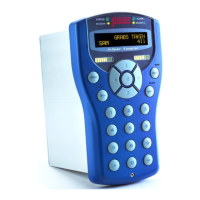SECTION 3: DATA COMMUNICATIONS
3.1 WHAT IS IT?
The purpose of data communications is to transfer information between two or more units. As a rule, it is
characters (text or numbers) and/or instructions (commands) that are transmitted. The simplest level of computer
language is binary digits where each character is composed of seven to eight binary 1’s or 0’s.
The computer processes binary characters made up of 1’s or 0’s. Each of the characters is called a bit.
By combining several bits, a binary character set can be constructed. The most common system, ASCII, contains
128 characters, each of which is made up of 7 bits, ASCII is commonly extended to 8 bits, or 256 characters. 8
bits are known as a byte and a kilobyte (kB) is made up of 1024 extended ASCII characters.
All communication is carried out at this level, internally within the computer as well as externally with
other units. Internal communication within the computer is simple. However, as soon as the computer must
communicate with external units, a series of factors must be synchronised and controlled to ensure that the
transmission of data takes place correctly.
3.2 ONE BIT AT A TIME, OR A WHOLE BYTE?
There are two ways of transmitting data, by parallel or serial transmission.
3.3 PARALLEL TRANSMISSION
The InSpec does not support parallel data communication.
Parallel transmission is faster and simpler since the entire character with its 8 bits is transmitted in a
single operation using 8 transmission paths, one for each bit. All communication within the computer itself takes
place via parallel paths in the internal data bus so that the entire character or several characters can be
simultaneously transmitted.
Parallel transmission via a multi-conductor cable (Centronics-type) can only be carried out at short
distances for practical and economic reasons. Therefore, the majority of all external data communications is
achieved through serial transmission; i.e. the bits are sent one at a time on a single transmission path.
3.4 SERIAL TRANSMISSION
Serial transmission places higher demands on the receiver and the transmitter that must keep track of
when the character starts and ends, and of the inherent sequence of bits. The transmitter and receiver must
transmit and receive at the same rate. This is known as the transmission speed and is expressed in bit/s (bits per
second).
To tell the receiver where a character starts and ends the transmitter sends out extra bits, a start bit and
one or more stop bits.
3.5 SIMPLEX, HALF DUPLEX OR FULL DUPLEX?
The following is based on a simple RS232 connection.
3.6 SIMPLEX
When communication only takes place in one direction e.g. a computer sends an ‘on/off’ signal to a
motor. This is called simplex transmission. However, if the motor then has to reply that it is functioning then
duplex transmission is required.
3.7 HALF DUPLEX
Half-duplex transmission means that the communicating units must take turns in sending out signals, i.e.
communication can take place in both directions but not simultaneously.
3.8 FULL DUPLEX
Full-duplex transmission is two-way simultaneous transmission.

